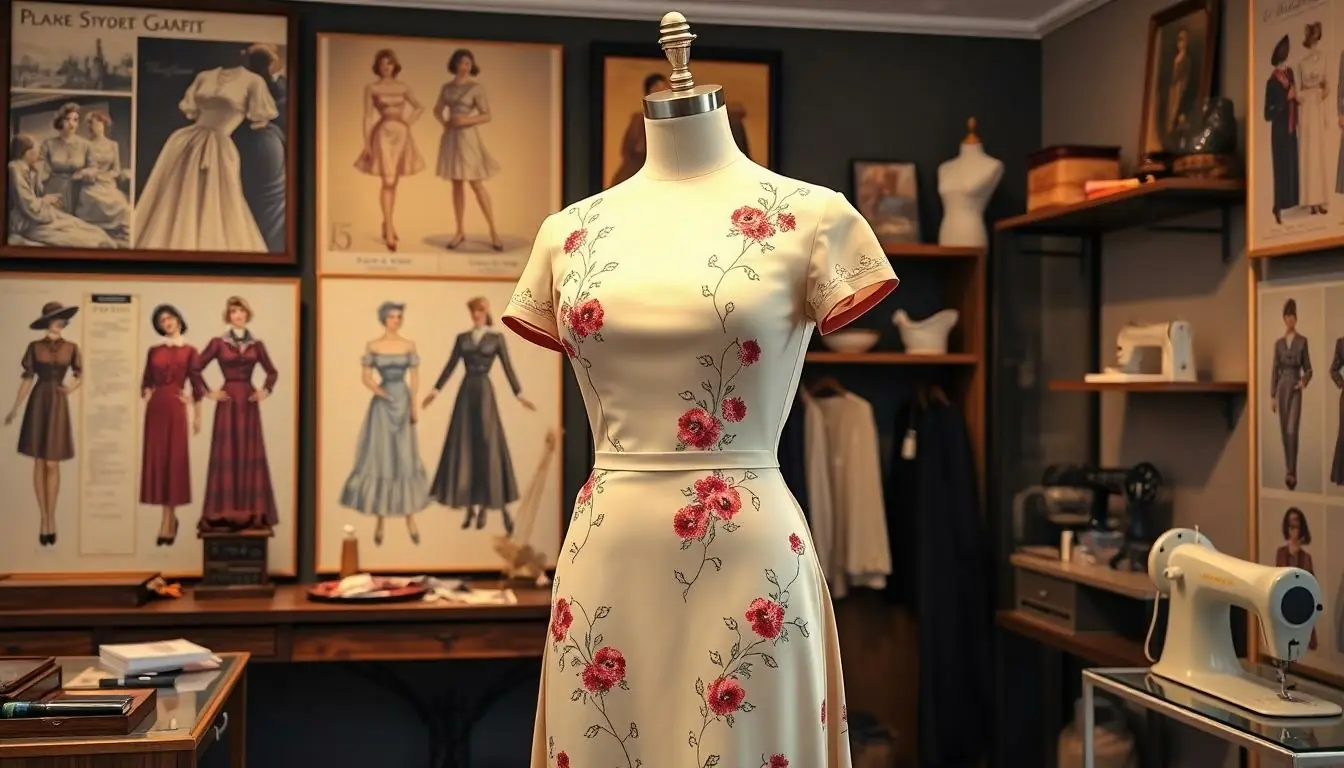Table of Contents
ToggleFashion isn’t just about clothes; it’s a time machine that transports us through decades of wild styles and bold statements. From the flapper dresses of the 1920s to the grunge looks of the ’90s, it’s a rollercoaster ride of creativity and self-expression. Each era has its own flair, proving that what’s in vogue today might just be tomorrow’s cringe-worthy throwback.
As trends evolve, they reflect societal changes and cultural influences, often with a hint of humor. Who could forget the oversized shoulder pads or the infamous low-rise jeans? Fashion trends have a way of making us laugh and cringe all at once. So buckle up as we dive into the fascinating evolution of fashion trends, where each stitch tells a story and every outfit has a past.
The Evolution Of Fashion Trends
Fashion trends exhibit significant shifts across decades, influenced by social movements, technological advancements, and cultural phenomena. The 1920s introduced flapper dresses symbolizing women’s liberation. In contrast, the 1960s embraced psychedelic patterns, reflecting the counterculture movement.
Each decade marked distinct styles, such as the glamorous looks of the 1950s, where cinched waists and full skirts dominated. The 1970s followed with bohemian styles, including bell-bottoms and vibrant prints, emphasizing individuality. As societal values evolved, so did fashion; the 1980s showcased bold statements with oversized silhouettes and flamboyant colors.
Cultural influences facilitated the development of unique trends. Hip-hop emerged in the late 1970s, impacting street style with baggy pants and graphic tees. As punk rock gained popularity, leather jackets and combat boots highlighted rebellion and nonconformity. Each era’s music and art scene undeniably shaped fashion expressions.
Technological changes also altered industry practices. The introduction of synthetic fabrics in the 1960s led to innovative designs and increased affordability. Digital media further transformed fashion in the 2000s, allowing brands to reach global audiences quickly.
Memorable trends often evoke nostalgia. The resurgence of 1990s grunge reflects current preferences for vintage aesthetics and sustainability. Oversized shoulder pads from the 1980s even experienced a comeback, illustrating the cyclical nature of fashion.
Fashion continues to evolve, driven by changing cultural landscapes. Increased emphasis on inclusivity and sustainability now guides many modern brands. Trends emerge more rapidly, reflecting the fast-paced world we inhabit today.
Early Influences On Fashion

Fashion’s early influences shaped styles that reflect societal norms and artistic expressions. Historical contexts and key designers played pivotal roles in defining these trends.
Historical Context
Ancient civilizations set the groundwork for fashion. Egyptians adorned themselves with linen garments and intricate jewelry, representing social status. Greeks embraced draped fabrics, emphasizing the beauty of the human form. The Middle Ages introduced structured silhouettes and modesty through corsets and flowing gowns, influenced by religious ideals. The Renaissance era sparked creativity, showcasing opulent fabrics and embroidery. Each period contributed distinct styles, driven by culture and necessity. Innovations such as the printing press in the 15th century further enhanced fashion dissemination. Global interactions, particularly during the Age of Exploration, expanded trends through trade and colonization. Thus, historical context laid a foundation that continues to impact modern fashion.
Key Designers
Pioneering designers emerged, influencing fashion’s trajectory. Charles Frederick Worth, often dubbed the father of haute couture, introduced the concept of the fashion show in the mid-19th century. His intricate designs set standards for elegance and craftsmanship. Coco Chanel revolutionized women’s fashion in the early 20th century, promoting simplicity with her iconic jersey dresses and the little black dress. Christian Dior’s “New Look” in 1947 redefined femininity, emphasizing an hourglass silhouette after World War II. Jean-Paul Gaultier challenged norms with his eclectic styles and punk aesthetics during the late 20th century. Designers like Yves Saint Laurent and Giorgio Armani further shaped modern fashion, pushing boundaries through innovation. These influential figures left an indelible mark, shaping the evolution of trends that resonate today.
The 20th Century Revolution
The 20th century marked a significant transformation in fashion, driven by social, cultural, and technological changes.
The Roaring Twenties
The 1920s introduced a bold departure from previous styles. Flapper dresses emerged as symbols of women’s liberation, characterized by their loose fits and fringe details. Jazz music and the nightlife scene greatly influenced these fashion choices. Accessories like cloche hats and long pearl necklaces complemented the outfits, emphasizing a playful yet elegant aesthetic. This era celebrated freedom and individuality, contrasting sharply with the conservative styles that came before. Fashion magazines began to flourish, showcasing the latest trends and dictating styles for the masses. Designers such as Chanel popularized chic simplicity, forever shaping women’s fashion.
The Influence Of War
World War I and World War II had profound effects on fashion. During World War I, women’s roles expanded, leading to practical clothing like tailored suits and shorter hemlines. The constraints of wartime rationing influenced fabric choices, making utility a priority. After the war, the 1920s brought about a celebration of freedom, sparking the flapper movement. World War II shifted focus again, with women entering the workforce and adopting more functional styles. Fashion became a reflection of resilience and adaptability. Iconic designs, such as the New Look by Dior post-war, revitalized femininity, showcasing a return to elegance amidst recovery. Each conflict reshaped societal norms, leading to evolving trends that defined the subsequent decades.
Technological Advancements
Technological advancements significantly shaped the evolution of fashion. These developments influenced design, manufacturing, and distribution processes.
Impact Of Mass Production
Mass production revolutionized fashion by making clothing more accessible. Before this, garments were often custom-made. Factories emerged in the late 19th century, allowing brands like Levi’s and Brooks Brothers to produce in bulk. As a result, prices decreased, enabling working-class individuals to wear stylish clothes. Similarly, the availability of ready-to-wear collections in the 20th century introduced new trends at a faster pace. This shift also encouraged brands to create diverse styles, appealing to a broader audience. The impact is clear: today’s high street fashion thrives on this mass production model, fueling quick changes in trends.
The Role Of Social Media
Social media transformed the fashion landscape by democratizing influence. Platforms like Instagram and TikTok allow consumers to share personal styles, connecting people globally. Influencers play a crucial role, promoting brands and trends instantly. In fact, a single post can spark widespread adoption of styles, showcasing how fast trends can evolve. User-generated content drives engagement and encourages brands to adapt their strategies. Fashion weeks and runway shows gain extended reach through live-streaming, further blending the gap between designers and consumers. The role of social media remains pivotal, redefining how fashion trends emerge and spread.
Current Trends And Future Directions
Fashion trends continue evolving, with a strong emphasis on sustainability and digital innovation shaping the landscape.
Sustainable Fashion
Sustainable fashion focuses on environmental and ethical considerations in the industry. Designers now prioritize eco-friendly materials, such as organic cotton and recycled polyester, to reduce waste. Brands increasingly implement transparent supply chains to ensure ethical labor practices. Consumers show a growing preference for second-hand shopping, drastically impacting fast fashion’s traditional model. Initiatives like clothing rental services also gain popularity, enabling people to access trendy pieces without the environmental cost. The rise of capsule wardrobes encourages intentional purchasing, allowing individuals to invest in timeless pieces.
Digital Fashion Innovation
Digital fashion innovation increasingly influences how brands create and market clothing. Blockchain technology enhances transparency, providing verified authenticity and traceability in the supply chain. Virtual fitting rooms allow shoppers to try on clothes through augmented reality, improving shopping experiences. Designers explore digital-only collections, pushing boundaries on creativity without the constraints of physical materials. Social media platforms generate dynamic campaigns that engage consumers directly, reshaping marketing strategies. As virtual fashion shows gain traction, they highlight the industry’s adaptability in a changing landscape.
Fashion’s evolution is a testament to the dynamic interplay between culture and creativity. As trends rise and fall they reveal much about societal values and individual expression. The journey from the flapper dresses of the 1920s to the sustainable practices of today showcases a landscape rich in innovation and adaptation.
With technology and social movements continuing to shape the industry the future of fashion promises to be even more diverse and inclusive. As consumers become more conscious of their choices the focus on sustainability and ethical practices will likely redefine what it means to be fashionable. The ongoing dialogue between past and present ensures that fashion remains a vibrant reflection of human experience.




